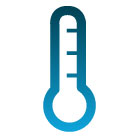Did you know you can save up to 10 percent on heating and cooling costs by investing in a programmable thermostat?

Invest in a Programmable Thermostat
Did you know you can save up to 10 percent on heating and cooling costs by investing in a programmable thermostat? Plus, you may be able to get a cash rebate when you buy one. You’ll save energy without even realizing it, and your new thermostat will pretty much pay for itself over time.
But, keep in mind, energy savings are highly dependent on the settings you select. (Do you really need your AC cranked up to sweater-wearing temps?)
Wash With a Strategy in Mind
We consume a lot of water when we shower, wash dishes, and do laundry. The good news is that saving is easy – just lower the temperature of your water heater from the typical 140 degrees to 130 degrees, and you could save 3 to 5 percent on energy costs. If the hot water from your tap almost burns your hand, your setting is too high.
Consider installing low-flow shower heads and faucet aerators that reduce your water use. Like the thermostat, this investment will pay for itself.
The clothes dryer is one of the largest energy users in the home, often consuming as much as a refrigerator, dishwasher, and clothes washer combined. Air-dry clothing when possible, and be sure to clean the lint filter after each use and use the auto-dry or moisture-sensor setting.

Unplug And Power Down
It’s hard to believe, but many household devices – from TVs and DVD players to microwaves and coffee makers – consume energy even when they aren’t even being used. This is called “standby power” and accounts for around 10 percent of your energy bill.
Another common energy waster is charging your cell phone at night. It only only takes a few hours to reach maximum charge but consumes energy the entire time.
Buy Smarter Light Bulbs
An LED light bulb uses up to 85 percent less energy to deliver the same amount of light as incandescent. They also reach full brightness instantly and can work with dimmer switches.

Seal Cracks in Your House
If you add up all the gaps around the windows and doors in an average house, you have the equivalent of a 3-foot by 3- foot hole in the wall. Caulk and weather-strip to seal off air leaks and use window putty to seal gaps around loose windowpanes.
Get A Free Energy Audit
Ask your utility company if it provides free energy audit. A professional will assess your home and make suggestions for improvements. You can also visit EnergyStar.gov's home improvement section for more tips and advice.
Category: Credit & Budgeting



